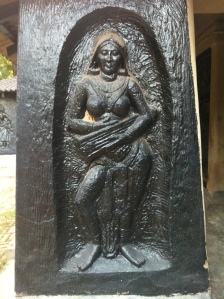A note on the title. [1]
A young guy with a sandy brown mop of hair, t-shirt, khakis, and sneakers crouched about 10 feet from where I stood in Dilli Haat, an outdoor crafts market in New Delhi, and focused his telephoto lens. My eyes followed the direction he pointed his camera, where I saw it to be aimed at one of the artisans who had come to sell his wooden handicrafts. About 80, the artisan is wearing a crisp, white sherwani, amidst bright pink and yellow sheets of fabric suspended from a stone tower in a pattern evocative of one of the hundreds of wedding tents one sees around Delhi during winter wedding season. His weathered and well-wrinkled face was serene, and he adjusted his skullcap as a coolish breeze came through the fabric around him. He had no idea this young white man was taking a photo of him.
It was a poetic scene, to be sure. Not unlike the hundreds of National Geographic photos we’ve all seen. The young man with the camera clicked about 10 shots in a matter of seconds, ran his fingers through his now-ruffled hair, and walked away, camera still in hand, poised for the next shot.
This all transpired in about 30 seconds, if that. I was uneasy for the rest of the afternoon, because the scene surfaced many complicated emotions I’ve had throughout my few weeks here in India, specifically on the subject of taking photos. When I flipped through the photos on my phone I noticed that they were almost exclusively of inanimate objects, no Indian people in any shots. I’m not speaking of photos with friends, colleagues or family – I have no compunction about those. Here, I refer specifically to photos of people I don’t know, or hardly know: people walking down the street pushing vegetable carts teeming with the reddest carrots you’ve ever seen in your life, children playing badminton without a net, women in saris of every hue, and yes, even those women from nearby towns and villages whom I met just once and for a few moments, through a local NGO that they work with, or the small children who smile a thousand watts and throw a peace sign when a foreigner with a camera passes by them (these latter two being willing subjects).
India is captivating. It is teeming with character and color. It is teeming with people. As a person born, but not raised here, I experience that beautiful confusion that many of us children of American immigrants feel when they visit their countries of origin: places where they do not have to hyphenate their identities. Here I’m just Indian, despite my Western privilege and some very conspicuous American habits. But, irrespective of residence or citizenship, I’ve never been seen by others as, not felt myself, just “American.” “No, but where are you really from?” People often ask if I happen to answer ‘New York’ to the first question. And perhaps that is why I felt queasy and maybe even a little angry, when I saw that guy literally objectify an Indian person.
Now, what? What do I make of my unease? Do I stop taking photos of places I travel? Do I think others should as well? Not exactly. Am I asking questions to which there are singular and clear answers? Definitely not. Here, I think the tension between belonging and being foreign can offer something. I am not quite “from” here. Nor am I “from” the United States. I am not (for the most part) the documented, nor am I able to fully hold a Western gaze when looking at India. This liminal space offers me access to a certain intimacy and distance that might prove useful. Some reflections:
I. On objectification: This is not a new concept in relation to images or photography. Feminists around the world are vigilant against the objectification of women. But what the question of objectification offers us is in this context is a third perspective, not just the relationship between objectifier and objectified, not just the intent of the photo, not even the impact on the objectified, but the question of the ‘gaze.’ This third element affords us nuance in the midst of asking who is taking whose photo and for what, and pushes us to ask the question: how is the photographer SEEING through their lens? Do they want to show the exotic locales to which they’ve travelled to their learned friends? Do they want to document the horrifying poverty, which they previously couldn’t have imagined? Do they want to document the beauty of a particular scene for their own pleasure? Regardless of the responses to the questions of “why” when we raise the question of objectification we are forced to ask: HOW?
Evoking in me memories of Edward Said’s description of orientalism as consumption of the East by the West without contributing to it, I can’t know exactly how the young white guy was seeing the old Indian artisan in the sherwani at Dilli Haat. I can only speculate that he didn’t care enough about the desires of man himself to ask whether he might take a photo of him. Whether it’s my political sensibilities or my Indian-ness or something else altogether, I’m unable to see the man as merely a subject for a photo. In On Photography, Susan Sontag asserted, “Photographs really are experience captured, and the camera is the ideal arm of consciousness in its acquisitive mood. To photograph is to appropriate the thing photographed. It means putting oneself into a certain relation to the world that feels like knowledge — and, therefore, like power.” The gaze in question confers power, and that is the essence of objectification.
II. The question of gaze is incomplete without a socio-historical analysis, which places photography amidst the ever-present questions of imperialism, colonialism and capitalism. It cannot be so easily forgotten that the “West” once sought to own every single part of India: the land, the resources, the labor and property of each person, from the farmworkers to the kings. Depending on how one perceives current capitalist models, this is something that has not changed – previously it was imperial conquest by nation-states, today it is the same conquest but by multinational corporations, based in Western countries. In this context, taking a photo is undoubtedly a political act.
III. On documentation: Memory is fragile: individual and political, both. The impulse to record is universal, as an aid to memory, as a means of passing information through generations, as a way to reflect and relive. This is an impulse I feel strongly, both on a personal level, having lost my last living grandparent this year and on a political one, working for the past decade in a movement for social justice that sometimes spins its wheels and sometimes forges great breakthroughs. All this, while the emergence of social media reliant on photographs is at the center of many of our worlds. There must be questions can we ask that would help us illuminate the difference between documentation and objectification – but for the purpose of this piece, I invite us to avoid jumping to these questions while eliding the former.
There is so much more to be said about India — it’s remarkable journey through colonialism; the rooted and powerful social movements resisting the internal scourge of the caste system; and the external one of neo-liberal development models that are ravaging the livelihoods of the poor. There is a feminist fire ablaze here on questions of dowry, female feticide and infanticide and violence against women and girls. The capital city just held elections that will undoubtedly shape the trajectory of the region for years to come.
The way that I see India has prevented me from feeling comfortable taking a picture of a person I don’t know, and I certainly couldn’t abide such a photo being taken without the person’s knowledge and consent. Perhaps that is because the way I see India is also about the way I feel seen when I am here. A part of who I am is visible here in a way that it is not in other places in the world. Perhaps I an hyper-vigilant when because I know how it feels to be reduced to a shade of your identity, to be tokenized, exoticized, and made other. Perhaps because the legacy of colonialism is so present contemporary struggles faced by Indians. There is so much more to be said about India, but I raise the question of photography as an entry point into some of these conversations, because the gaze is where our understanding begins. Because the way we see is as important as what we see.
[1] This phrase refuses the First and Third world categorical hierarchy and instead uses a demographic lens, and acknowledges the “Third World” as the part of the world where 2/3 of the global population resides. I could also have used Global South, but want to make the point about space, physical and psychic.



I do think the answer is quite simple and clear. Don’t take pictures of people you don’t know unless you have obtained permission. Do not treat people as objects. I love this article, but I was a little annoyed that you backed away from making a stronger statement for a change in behavior.
Important questions, for sure. I’ve often faced a similar quandary with regard to shooting a photo of someone I don’t know. For me, the issue resides somewhere in the middle of all of this. I’ll often see a moment and hold back from shooting because I’m held prisoner by the complexities. But sometimes, I shoot first and allow my objections to emerge after.
In short, there are so many ways to handle things as a photographer that it’s kind of impossible to guess what someone else might be thinking when shooting a photo. Sometimes it IS just about “getting the shot” (which may or may not be primarily aesthetic in nature) but then, the shot itself can also trigger new reflections later.
I’ve often felt sad for holding back over issues of politics and objectification, because sometimes it’s the surreptitious, candid, street image that serves as the best type of portrait or trigger for further research or contemplation. It need not be a “stolen moment,” either. There are ways to engage with people after the fact. I’m aware that these types of questions are biased towards the photographer’s experience, but sometimes, choosing NOT to shoot the photo you see before you is just as problematic, perhaps more so, because then the moment is less likely to be reflected upon.
In other words, photography is ambivalent. Choosing not to shoot a photo may seem like a “respectful” gesture (and it might be…because politeness counts). But it could just as easily be read as a kind of “withholding of power,” with all of its political implications intact. Choosing not to shoot can become a way to render someone invisible once more.
I think the best way to address much of what you’ve brought up is simply to keep the questions in play. A photo doesn’t ever really “rest” in some kind of final form or meaning, and nor should we. But sometimes it’s better to argue about the shot you’ve taken rather than the moment you can only talk about abstractly later on. (Either way, I’m happy to have stumbled across your page.)
Many photographers I know and read jump through hoops to justify taking pictures of people they don’t know without their permission. I don’t do it because it seems to me the jury is back on this. People in many areas of the world are objecting to having their picture taken, or want to be paid, or want to be consulted – in short, people seem to want agency rather than non-agency.
As a photographer, I choose to honour what seems to me to be a consensus that has emerged and avoid photos with people where I don’t have consent. There have always been rationalizations for the privileged to ignore the agency of others. I don’t believe photographing without consent is any different. Whatever Henri Cartier-Bresson did, the world has now moved on and I refuse to put my “art” before other peoples’ agency.
Sometimes people are not the main subject of a photo, or at any rate are not important as recognizable people. A crowd scene at a sporting event, say, a baseball game – I don’t see that permission is necessary or even possible, given that there may be dozens or hundreds of individuals in the photo. Small group of tourists dwarfed by large attraction, say, the Grand Canyon or the US Capitol Building – not necessary, in my opinion. Medium range photos are more tricky. If the person isn’t a large part of the image or their back is to the camera or they are silhouetted, it might be reasonable to shoot first and ask permission /offer to delete/ offer to pay/ offer to print (portable printer 4 x 6 print) next minute. Yes, it is exceedingly rude to shove a camera in someone’s face. If the photographer wants a portrait, ask first, of course. If you wouldn’t do it in the USA, don’t do it elsewhere. If you aren’t sure about regional attitudes to photographers, do research first, and be polite, ask.
Thank you for writing this.
Really important and stimulating piece, I appreciate the thoughtfulness and seriousness. As obvious as the answer to such questions may seem to some, many people are too preoccupied by their own sense of entitlement to even pose the question. I remember this uneasiness, and this conversation coming up many times when I was traveling in Ghana.
My epiphany was when I tried to photograph the local fish-seller in front of my host family’s house while I was a Peace Corps volunteer. He refused his consent, concerned that the photo might be published somewhere. It was a valid point (though I had no such intentions, which is irrelevant, really), and since that day I have made sure to ask on the rare occasion I want to photograph a person. Mostly I focus on the inanimate. And I stopped buying RPCV calendars, because I could not find any indication of concern with consent and proper identification of photo subjects in the application materials for submitting photos for publication in the calendars.
And every time I see that famous 1985 photo of Sharbat Gula whose name Steve McCurry didn’t even bother to document so that National Geographic staff (and by extension, global viewers/readers) simply referred to her as “the Afghan girl,” I wonder about her feelings about being objectified on such a grand scale, her portrait used for political banners and advertising and memorabilia and whathaveyou, and I worry that she did not consent.
Doing a little digging, I see that that the photographer talked to her teacher for permission but never asked her directly. So the 12-year-old didn’t really consent but complied with authority. Not a surprise, really. It took 17 years for NG to redress the situation, and I guess McCurry did try to follow up before then, and it did result in the creation of the Afghan Children’s Fund. Those are good things, but they don’t erase the original problems around consent.